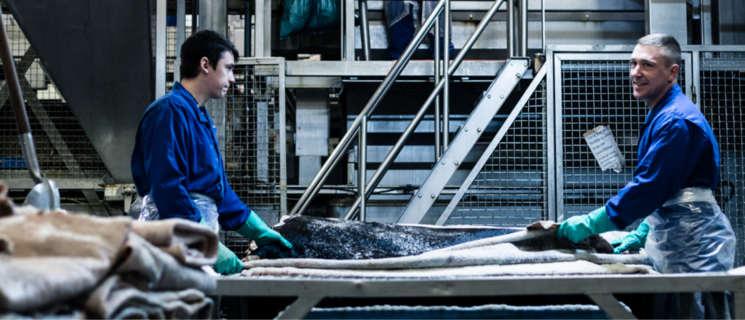No two animals are the same. Every calfskin we supply is as unique as a fingerprint and our entire chain handles it with the utmost care. Transport, calf husbandry and veal processing companies: each link contributes to achieving a high quality and sustainable end result. It isn't for nothing that our calfskins are a much sought-after product all over the world.
Quality-conscious in the chain
At our veal processing plants, the calfskin is removed from the carcass with the greatest care. The skins are then transported to Oukro, the VanDrie Group's calfskin-processing subsidiary, and checked for damage. When a calf is young, hide damage can heal without visible scars. However, the scars remain under the hide. It is therefore important that every employee treats the calves calmly and carefully. A small, incorrectly fitted bolt in a stall can already result in damage to the calf’s hide.
After detailed inspection and classification, the calfskins are preserved. This generally takes place by salting the skins to extract moisture from the skins and then folding them, after which the skins are left for 14 days for optimal preservation. Proper preservation extends the shelf life of the skin. This is necessary because about 85% of the calfskins are exported to tanneries all over the world.
Skin salting puts pressure on sustainability performance. Before further processing, the skins must be stripped of salt by rinsing. This increases our customers' water consumption and disposal of dirty water. Nowadays more and more calfskins are freshly delivered to the customers. For this purpose, the calfskins are cooled at Oukro and delivered the next day. This allows the customer to process the calfskin directly, which makes salting unnecessary.
As a result, the proportion of salt used to preserve a skin has been reduced by 14% in 2019 compared to 2009.
From calfskin to designer bag
To get from calfskin to calf leather, there are roughly four steps. These take place at buyers of our calfskins: tanneries all over the world.
Step 1: skins are washed and soaked at a tannery after arrival, and excess hair and collagen are removed - as well as dirt, fat and meat residue still present on the skin.
Step 2: A calfskin consists of a so-called bottom layer and upper layer. In order to obtain calf leather, the upper layer, or top layer, must be separated from the bottom layer. This is done in a splitting machine. The underlayer can be used for suede and similar leather products. The top layer is further processed into leather.
EVERY CALFSKIN IS AS UNIQUE AS A FINGER PRINT.
Step 3: Leather is a natural product and must be further processed to ensure suppleness and strength. One way of doing this is by drying the skin. This extends the lifespan of calfskins.
Step 4: A final, mainly aesthetic, step is the application of structure to the leather. Depending on the future use of the calfskin, a supple, smooth or rough structure is chosen.
Where does it go?
With its many fashion houses, Italy is the largest sales market for our calfskins In 2019, about 60% of our skins went to the Italian leather industry. Approximately 18% of our calfskins are processed in the Netherlands and 22% go to China, Japan, Spain, France and Germany. Our calfskins subsequently find their way to tanneries, producers of shoes, bags and clothing and to the automotive industry for upholstery of interiors.
![[Translate to English:] [Translate to English:]](/fileadmin/_processed_/2/3/csm_een_duurzaam_kalfsvel_7524450395.jpg)
![[Translate to English:] [Translate to English:]](/fileadmin/_processed_/a/9/csm_Oukro_VanDrie_Group__c__Annemarie_Dekker-12_fdf883fc24.jpg)
